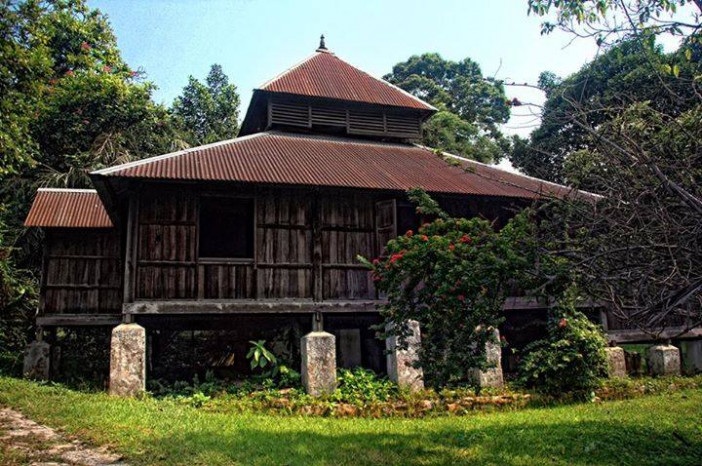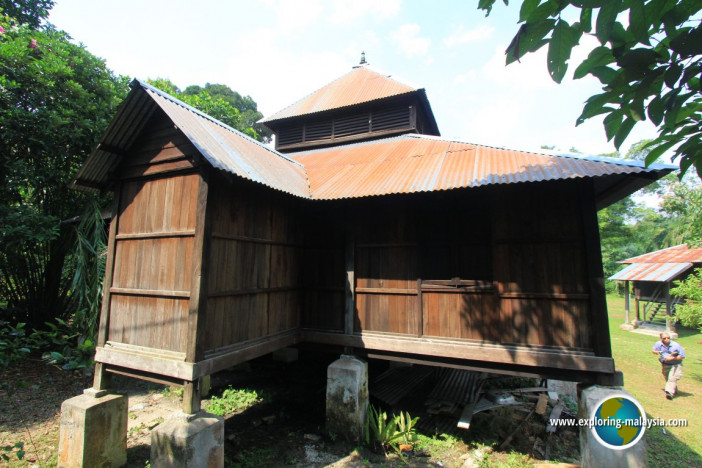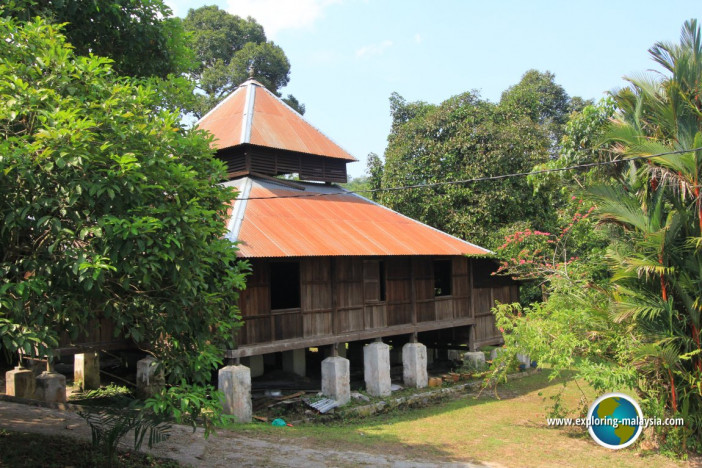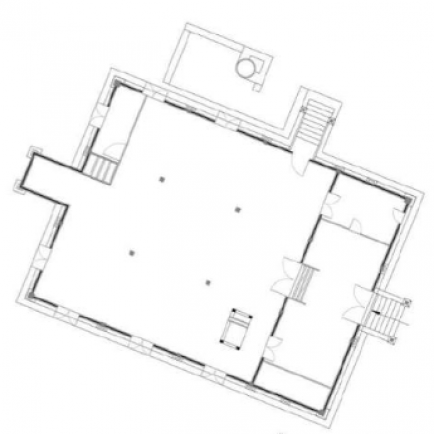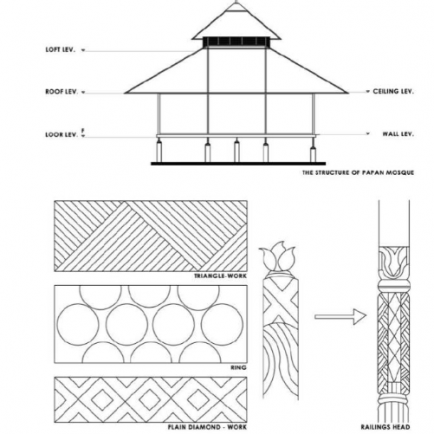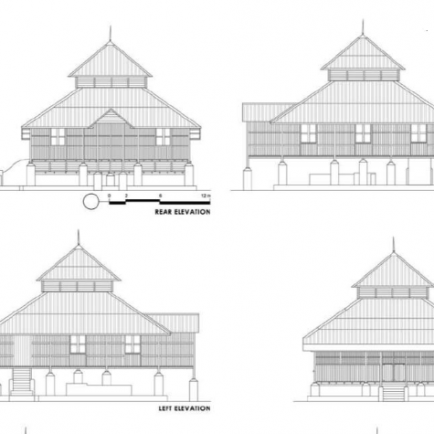Kampung Papan Mosque
History
Masjid Papan was built by Raja Bilah, a son of a king from Sumatra of Mandailing descent. He fled from Mandailing, Sumatra and later migrated to Malaya after a power struggle in the palace.
Raja Bilah with his wife and family settled in Pekan Papan in 1877. As he was an influential and respected person for his authority and extensive religious knowledge, Raja Bilah was appointed Penghulu Mukim Belanja by the British in 1882.
Pekan Papan began to grow rapidly. around 1887 and the Malay population of Muslims also increased. Tuan Syed Al-Fadhil Sheikh Mohd Taib, who was the Perak Islamic Religious Leader at the time, called for a mosque to be built in this village to accommodate the large congregation.
On his concern, Raja Bilah endowed a piece of his land for the construction of the mosque and it was completed in 1888.
Urban and Architectural
The mosque is designed according to the concept of a layered five-fold roof or known as the Juglo roof due to its multi-storey roof. The roof is in the shape of two pyramids that grow and taper at the bottom. It does not have any towers and the call to prayer is chanted by beating a drum or taboh located in the role. The mosque does not have a bathroom and ablutions are performed at a nearby well.
The layout plan is simple, rectangular in shape and erected on stilts. Basically, the mosque has a foyer, prayer room, mihrab and pulpit while there are also additional spaces such as siak room, attic and imam room. This foyer space is rectangular in shape with walls and windows.
There are openings in the front wall that serve for ventilation and lighting. This space is often used as a place for the congregation to relax and discuss. There is a room reserved for the muezzin in this foyer and it is separated by a wooden wall arranged vertically. There is a wooden staircase that connects the foyer with the prayer room.
This prayer room is a place for religious activities, meetings and feasts and it is surrounded by four main pillars 5.57 meters high. The columns are used to support the roof structure at the top.
The pulpit space is placed to the right of the mihrab and it is carved with beautiful carvings made of medang wood. There is a small room known as the priest's room located next to this pulpit space. It is used to store the necessities of the mosque and a place for the imam to rest. The attic is located at the top and is connected by a portable wooden staircase. It also has openings called wind inserts connected by mortise and tenon and made of meranti wood.
Design elements and building materials The construction
structure of this mosque uses materials from cengal wood, merbau and red sea resin for the floor, beams, doors, walls, windows and pillars while the front staircase is made of cement finish. The roof is covered with a zinc roof.
The design of this Board Mosque is influenced by architecture from Sumatra, Chinese and English which can be seen in the design of its layered roof, the adaptation of carved motifs such as triangles on the pulpit, mihrab head and door.
The mosque is also decorated with carved motifs based on plants, cosmos and geometry such as larat clouds and drizzle flowers that can be seen on important spaces such as the entrance, mihrab and pulpit. It uses the technique of making traditional silat carvings in half -punch and embossed punch.
Description
Masjid Kampung Papan is an old mosque in the town of Papan, Perak. Its design is different from most of the mosques in the state. This is because Masjid Kampung Papan was built in the Mandailing style of Sumatra. I led a group from the Penang Heritage Trust to visit this mosque. We were on a heritage tour of Perak in the company of Mr Law Siak Hong, the Vice President of the Perak Heritage Society.
According to Mr Law, Masjid Kampung Papan is the oldest mosque in the Mandailing architectural style. It is even older than mosques in the Mandailing homeland of Sumatra.
References
https://www.penang-traveltips.com/malaysia/perak/papan/masjid-kampung-papan.htm
http://mandailing.weebly.com/masjid-papan-dipengaruhi-seni-bina-luar.html
Details
Location
Istana Raja Bilah, Papan, Perak, Malaysia.
Worshippers
200
Owners
Raja Bilah
Architect Name
Year of Build
1988
Area
127 sq.m
Drawings
Map
History
Masjid Papan was built by Raja Bilah, a son of a king from Sumatra of Mandailing descent. He fled from Mandailing, Sumatra and later migrated to Malaya after a power struggle in the palace.
Raja Bilah with his wife and family settled in Pekan Papan in 1877. As he was an influential and respected person for his authority and extensive religious knowledge, Raja Bilah was appointed Penghulu Mukim Belanja by the British in 1882.
Pekan Papan began to grow rapidly. around 1887 and the Malay population of Muslims also increased. Tuan Syed Al-Fadhil Sheikh Mohd Taib, who was the Perak Islamic Religious Leader at the time, called for a mosque to be built in this village to accommodate the large congregation.
On his concern, Raja Bilah endowed a piece of his land for the construction of the mosque and it was completed in 1888.
Urban and Architectural
The mosque is designed according to the concept of a layered five-fold roof or known as the Juglo roof due to its multi-storey roof. The roof is in the shape of two pyramids that grow and taper at the bottom. It does not have any towers and the call to prayer is chanted by beating a drum or taboh located in the role. The mosque does not have a bathroom and ablutions are performed at a nearby well.
The layout plan is simple, rectangular in shape and erected on stilts. Basically, the mosque has a foyer, prayer room, mihrab and pulpit while there are also additional spaces such as siak room, attic and imam room. This foyer space is rectangular in shape with walls and windows.
There are openings in the front wall that serve for ventilation and lighting. This space is often used as a place for the congregation to relax and discuss. There is a room reserved for the muezzin in this foyer and it is separated by a wooden wall arranged vertically. There is a wooden staircase that connects the foyer with the prayer room.
This prayer room is a place for religious activities, meetings and feasts and it is surrounded by four main pillars 5.57 meters high. The columns are used to support the roof structure at the top.
The pulpit space is placed to the right of the mihrab and it is carved with beautiful carvings made of medang wood. There is a small room known as the priest's room located next to this pulpit space. It is used to store the necessities of the mosque and a place for the imam to rest. The attic is located at the top and is connected by a portable wooden staircase. It also has openings called wind inserts connected by mortise and tenon and made of meranti wood.
Design elements and building materials The construction
structure of this mosque uses materials from cengal wood, merbau and red sea resin for the floor, beams, doors, walls, windows and pillars while the front staircase is made of cement finish. The roof is covered with a zinc roof.
The design of this Board Mosque is influenced by architecture from Sumatra, Chinese and English which can be seen in the design of its layered roof, the adaptation of carved motifs such as triangles on the pulpit, mihrab head and door.
The mosque is also decorated with carved motifs based on plants, cosmos and geometry such as larat clouds and drizzle flowers that can be seen on important spaces such as the entrance, mihrab and pulpit. It uses the technique of making traditional silat carvings in half -punch and embossed punch.
Description
Masjid Kampung Papan is an old mosque in the town of Papan, Perak. Its design is different from most of the mosques in the state. This is because Masjid Kampung Papan was built in the Mandailing style of Sumatra. I led a group from the Penang Heritage Trust to visit this mosque. We were on a heritage tour of Perak in the company of Mr Law Siak Hong, the Vice President of the Perak Heritage Society.
According to Mr Law, Masjid Kampung Papan is the oldest mosque in the Mandailing architectural style. It is even older than mosques in the Mandailing homeland of Sumatra.


